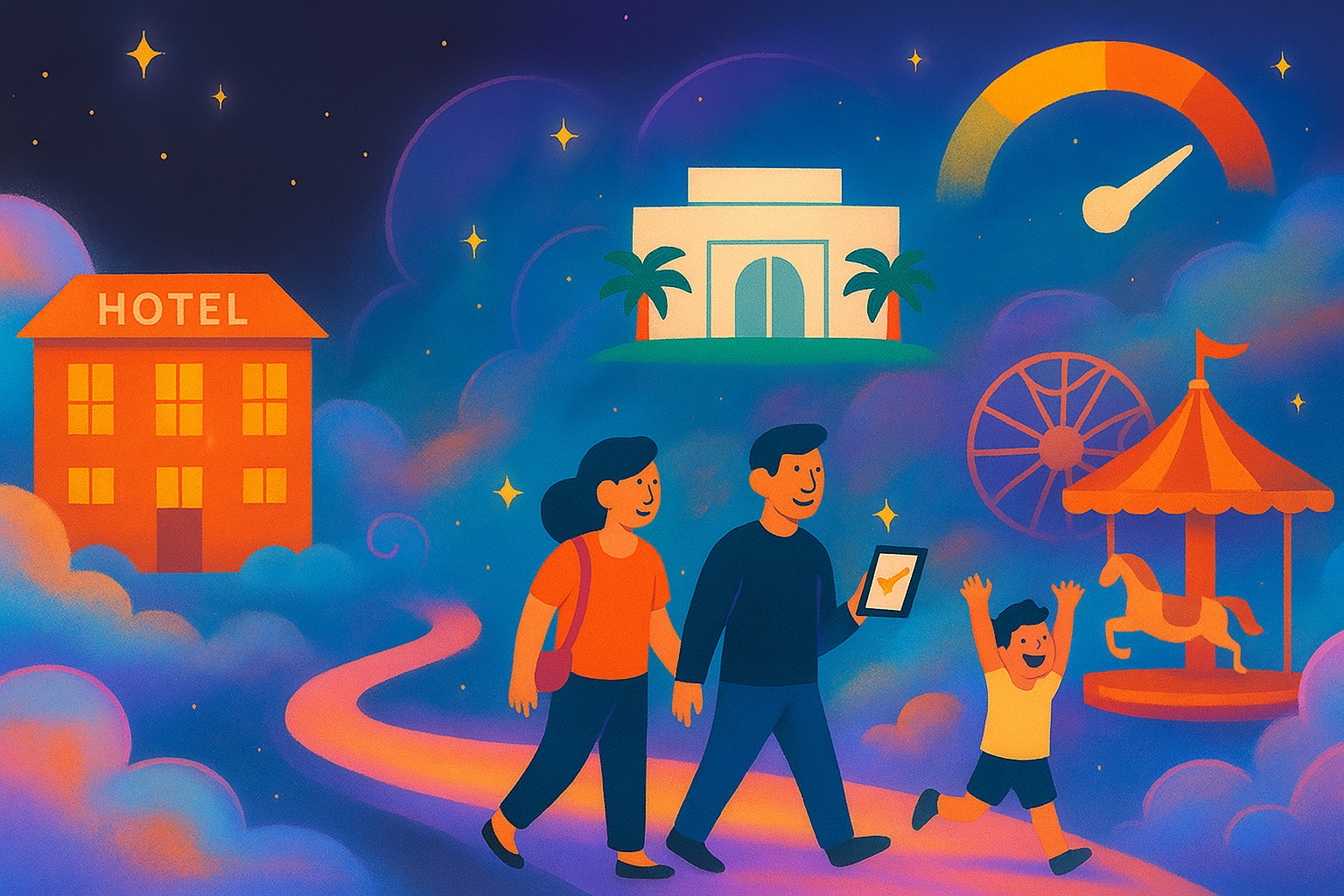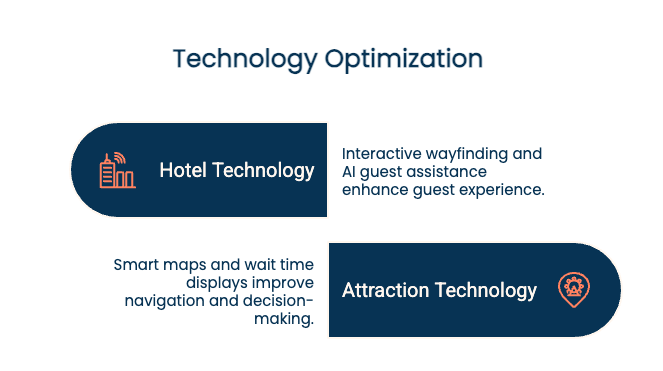How to create a guest experience strategy that drives loyalty in 2025

How to create a guest experience strategy that drives loyalty in 2025
This disconnect between venue priorities and guest needs isn't just anecdotal. Research from Medallia shows that personalization is a key factor for guest satisfaction, with 61% of hospitality and retail consumers willing to spend more with companies that offer personalized experiences. Yet many guest experience strategies still optimize for metrics that matter to spreadsheets but not to people.
This article breaks down the four essential steps you need to create a guest experience strategy that actually works: understanding real guest decision moments, identifying gaps competitors miss, leveraging your unique operational strengths, and implementing technology that solves problems rather than showcasing features.
What is a guest experience strategy?
A guest experience strategy is the systematic design of every interaction between your venue and your guests. It maps the complete guest journey—from initial discovery through post-visit memories—and identifies specific opportunities to create value at each touchpoint.
Unlike traditional customer service approaches, effective guest experience strategy focuses on guest behavior patterns rather than operational convenience. The best strategies answer this fundamental question: "How can we make this experience feel effortless and memorable?"
For hotels, this might involve understanding why business travelers feel anxious about wifi reliability and designing systems that eliminate that uncertainty. For attractions, it could mean recognizing that families make dozens of micro-decisions throughout their visit and providing information that helps them feel confident about those choices.

Why guest experience strategy matters for revenue and retention
Guest experience strategy directly impacts your bottom line through higher repeat visits, increased spending per guest, and stronger word-of-mouth recommendations.
For attractions specifically, strategic guest experience design creates measurable operational benefits. Well-designed experiences lead to longer visit duration or dwell time as families feel confident exploring more areas, higher secondary spending as guests discover amenities they might have missed, and increased likelihood of return visits with extended family groups who hear positive recommendations.
The ripple effects of exceptional experiences extend well beyond individual transactions. Research from Review Trackers shows that 40% of hotel guests are likely to write a review after a positive experience, while 48% will write a review after a negative experience. This means that superior guest experiences not only generate immediate satisfaction but also build the online reputation that drives future bookings.
The industry recognizes this shift toward experience-driven competition. According to Hotel Tech Report's 2025 State of Guest Technology study, 46% of hoteliers believe that guest experience technology will evolve more than any other category over the next five years. This indicates that venues investing in strategic guest experience now will have significant competitive advantages as the industry continues to prioritize guest-centric innovation.
Step 1: Map guest decision moments, not demographics
Focus on when guests need help, not who they are.
Traditional audience research asks who your guests are. Advanced guest experience strategy asks when your guests need help and how they naturally seek it.
Hospitality example: At hotels, for example, business travelers don't need "business amenities"—they need solutions for specific moments. When they arrive after delayed flights, they need rapid wifi access and immediate room readiness. When meetings run late, they need flexible dining options that accommodate their schedule changes.
Attractions example: Families visiting your zoo don't need "family-friendly features"—they need solutions for predictable challenges. When children get hungry at unpredictable times, they need food options near major exhibits. When parents are managing tired kids, they need clear information about shortest routes to exits and rest areas.
"We used to think we needed to understand everything about our guests—their age, income, where they come from,” says Takashi Nakaguchi, Nutmeg cofounder and CEO. “But the most important thing is much simpler: what problem are they trying to solve right now? Once you start thinking about moments instead of demographics, everything becomes clearer.”
Map these behavioral patterns rather than broad demographic categories. The most successful venues design experiences around genuine decision moments rather than assumed preferences.
Step 2: Identify competitor experience gaps
Look for unmet needs, not feature comparisons.
Effective competitive analysis for guest experience strategy goes beyond amenity lists. Study how competitors handle common guest problems and identify gaps in their solutions.
Hotel competitive analysis: If competing properties offer standard concierge services, look for opportunities to provide information guests actually need—real-time restaurant availability, transportation timing with traffic updates, local event information that affects their plans. Advanced solutions like AI concierges can provide 24/7 assistance for routine questions, freeing human staff to focus on complex requests that truly benefit from personal attention.
Related reading: The AI advantage in hospitality for attractions and hotels
Attraction competitive analysis: If other venues provide basic wayfinding, consider advanced solutions like real-time wait times, personalized itinerary suggestions based on family size and age groups, or location-triggered recommendations for nearby amenities. Smart maps show guests their exact location and provide intuitive navigation.
The goal is finding problems that competitors haven't solved, not copying features that already exist everywhere.
Step 3: Build on operational strengths that create guest value
Transform potential challenges into unique advantages.
Your unique value proposition (UVP) should emerge from genuine operational capabilities that solve guest problems. The strongest UVPs address issues other venues can't or won't tackle.
Hotel UVP examples: Maybe your property's complex layout naturally creates intimate spaces—leverage this for guests seeking privacy by providing clear wayfinding that highlights quiet zones. Perhaps your urban location creates noise challenges—become the venue that proactively manages sound comfort.
Museum UVP example: If your venue houses extensive collections across multiple floors, become the destination that makes discovery feel manageable rather than overwhelming. Provide smart wayfinding that suggests optimal routes based on visit duration and interests.
Step 4: Use technology that eliminates friction
Make the complex feel effortless.
The best guest experience technology disappears into usefulness. Smart venues use technology to eliminate friction while preserving human connection where it adds genuine value.
Consider how automated guest service is reshaping hospitality operations. Current research indicates that 70% of hotel guests find chatbots helpful for simple inquiries, freeing human staff to focus on complex requests that benefit from personal attention.
Hotel technology optimization: Interactive wayfinding or smart maps help guests navigate large properties independently, allowing staff to provide personalized recommendations rather than repetitive directions. Real-time room service ordering reduces wait times while enabling dietary customization that kitchen staff can prepare proactively.
Attraction technology optimization: Smart maps with current location tracking eliminate the navigation confusion that ruins many visits to large venues. Real-time wait time displays help families make informed decisions about which exhibits to experience when, optimizing their entire visit flow.

How leading venues implement guest experience strategy
Hotels that excel eliminate directional confusion through intuitive wayfinding and free staff for genuine assistance. Attractions that create memorable experiences use live information systems to help guests make confident decisions and design navigation that works the way families naturally think.
This is exactly what Nutmeg's smart mapping platform delivers. Real-time wayfinding eliminates confusion. Personalized recommendations surface relevant experiences at optimal moments. Operational insights reveal guest behavior patterns that inform smarter decisions about everything from staffing to space design.
The best technology doesn't announce itself—it simply works the way guests naturally think, turning potential frustration into moments of genuine delight.
Ready to see how smart maps can transform your guest experience? Learn more about Nutmeg's solutions.
Turn one-time visits into lasting connections






